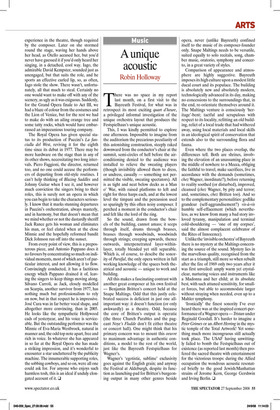A unique acoustic
Robin Holloway
There was no space in my report last month, on a first visit to the Bayreuth Festival, for what was in retrospect its most exciting quart d’heure, a privileged informal investigation of the unique orchestra layout that produces the Festspielhaus’s unique acoustic.
This, I was kindly permitted to explore one afternoon. Impossible to imagine from the auditorium the precarious peculiarity of this astonishing construction, steeply raked downward from the conductor’s chair at the summit, semi-circles of hell before the airconditioning denied to the audience was installed to relieve the sweating players (though invisibility allowed them to dress, or undress, casually — something not permitted the visible, sweating spectators). All is as tight and neat below decks as a Man o’ War, with raised platforms to left and right for three harps each, and at the lowest level the timpani and the percussion used so sparingly by this often noisy composer. I perched a moment in the conductor’s chair and felt like the lord of the ring.
So the sound, drawn from the bowels of the building, cannot amass; it seeps through itself, drums through brasses, brasses through woodwinds, woodwinds through strings; creeping upwards, thence outwards, interpenetrated layer-withinlayer, totally blended yet still separable. Which is, of course, to descibe the sonority of Parsifal, the only opera written in full working knowledge of the spaces both theatrical and acoustic — unique to work and building.
All this makes a fascinating contrast with another great composer at his own festival — Benjamin Britten’s concert held at the Snape Maltings. Odd that this justly celebrated success is deficient in just one allimportant way: it doesn’t function (or only awkwardly) as a theatre. Odd, because the core of Britten’s output is operatic (the three Church Parables and the pageant Noye’s Fludde don’t fit either theatre or concert hall). One might think that his primary concern was to mount this oeuvre to maximum advantage in authentic conditions, a model to the rest of the world, just like the Bayreuth Festspielhaus for Wagner’s.
Wagner’s ‘egotistic, sublime’ exclusivity goes against the English grain; and anyway the Festival at Aldeburgh, despite its function as launching-pad for Britten’s burgeoning output in many other genres beside opera, never (unlike Bayreuth) confined itself to the music of its composer-founder only. Snape Maltings needs to be versatile, suited equally to solo recitals, song, chamber music, oratorio, symphony and concerto, in a great variety of styles.
Comparison of appearance and atmosphere are highly suggestive. Bayreuth imposes its high culture upon a modest little ducal court and its populace. The building is absolutely new and absolutely modern, technologically advanced in its day, making no concessions to the surroundings that, in the end, re-orientate themselves around it. The Maltings venture is consciously ‘heritage’-bent; tactful and scrupulous with respect to its locality, refitting an old building, relict of a local trade that had withered away, using local materials and local skills in an ideological spirit of conservation that extends also to the surrounding flora and fauna.
Even where the two places overlap, the differences tell. Both are shrines, involving the elevation of an unassuming place in the middle of nowhere to a Mecca, obliging the faithful to travel, make sacrifices, live in accordance with the demands (sometimes, chez Wagner, inordinate?), before returning to reality soothed (or disturbed), improved, cleansed (chez Wagner, by pity and terror; and, sometimes, chez Britten too). And so to the complementary personalities: godlike grandeur (self-aggrandisement?) vis-à-vis humble self-effacement (which nevertheless, as we know from many a bad story invloved tyranny, manipulation and terminal cold-shouldering — ‘one of my corpses’, said the almost complacent celebrator of the Rites of Innocence).
Unlike the ‘invisible orchestra’ of Bayreuth there is no mystery at the Maltings concerning the source of the sound. Mystery lies in the marvellous quality, recognised from the start as a triumph, still more so when rebuilt after the fire of 1969 only two years after it was first unveiled: amply warm yet crystalclear, nurturing voices and instruments like a Madonna and her child; at its absolute best, with such attuned sensitivity, for smaller forces, but able to accommodate larger without straying when needed, even up to a Mahler symphony.
‘Ironically’ the finest sonority I’ve ever heard there was at the inspired concert-performance of a Wagner opera — Tristan under Reginald Goodall. It’s harder to imagine a Peter Grimes or an Albert Herring in the mystic temple of the Total Artwork! Yet something much more incongruous still actually took place. The USAF having unwittingly failed to bomb the Festspielhaus out of existence (as reported last month) then profered the sacred theatre with entertainment for the victorious troops: during the Allied occupation the wondrous acoustic resonated briefly to the good Jewish/Manhattan strains of Jerome Kern, George Gershwin and Irving Berlin. ❑










































































 Previous page
Previous page